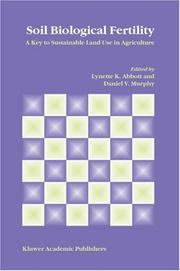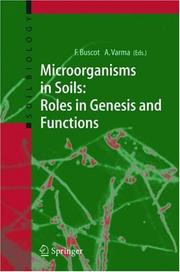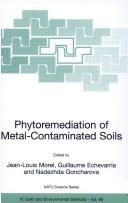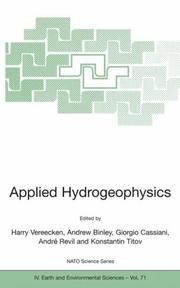| Listing 1 - 7 of 7 |
Sort by
|

ISBN: 1402017561 9781402066191 140206618X 9781402066184 1402066198 Year: 2007 Publisher: Boston : Kluwer Academic Publishers,
Abstract | Keywords | Export | Availability | Bookmark
 Loading...
Loading...Choose an application
- Reference Manager
- EndNote
- RefWorks (Direct export to RefWorks)
This book presents a comprehensive scientific overview of the components and processes that underpin the biological characteristics of soil fertility. It demonstrates the interdependence of soil biological fertility with physical and chemical characteristics of soil. The book highlights the enormous diversity of life in soil and the resulting effects that management of land can have on the contribution of this diverse community to soil fertility in an agricultural context. It is becoming more relevant to explore soil biological processes in terms of their contribution to soil fertility.
Soil biology. --- Soil fertility. --- Land use. --- Sustainable agriculture. --- Sols --- Utilisation du sol --- Agriculture durable --- Biologie --- Fertilité --- Environment. --- Soil Science & Conservation. --- Soil conservation. --- Plant science. --- Botany. --- Soil science. --- Plant Sciences. --- Low-input agriculture --- Low-input sustainable agriculture --- Lower input agriculture --- Resource-efficient agriculture --- Sustainable farming --- Agriculture --- Alternative agriculture --- Soils --- Fallowing --- Fertilizers --- Soil productivity --- Biology --- Natural history --- Land --- Land utilization --- Use of land --- Utilization of land --- Economics --- Land cover --- Landscape assessment --- NIMBY syndrome --- Fertilization --- Fertilizer movement --- Conservation of soil --- Erosion control, Soil --- Soil erosion --- Soil erosion control --- Agricultural conservation --- Soil management --- Botanical science --- Phytobiology --- Phytography --- Phytology --- Plant biology --- Plant science --- Plants --- Control --- Prevention --- Conservation --- Pedology (Soil science) --- Earth sciences --- Floristic botany --- Soil Science. --- Plant Science.
Book
ISBN: 9780387735634 9786611216788 0387735631 Year: 2008 Publisher: New York, NY Springer Science+Business Media, LLC
Abstract | Keywords | Export | Availability | Bookmark
 Loading...
Loading...Choose an application
- Reference Manager
- EndNote
- RefWorks (Direct export to RefWorks)
Systems at the surface of the Earth are continually responding to energy inputs derived from solar radiation or from the radiogenic heat in the interior. These energy inputs drive plate movements and erosion, exposing metastable mineral phases at the Earth's surface. In addition, these energy fluxes are harvested and transformed by living organisms. As long as these processes persist, chemical disequilibrium at the Earth's surface will be perpetuated. Chemical disequilibrium is also driven by human activities related to production of food, extraction of water and energy resources, and burial of wastes. To understand how the surface of the Earth will change over time, we must understand the rates at which reactions occur and the chemical feedbacks that relate these reactions across extreme temporal and spatial scales. This book addresses fundamental and applied questions concerning the rates of water-rock interactions driven by tectonic, climatic, and anthropogenic forcings.
bodembescherming --- geochemie --- hydrologie --- Geochemistry --- Pedology --- biogeografie --- bodemkunde --- Biogeography --- Geology. Earth sciences --- fysica --- Solid state physics --- Geochemistry. --- Materials --- Thin films. --- Geobiology. --- Hydrogeology. --- Soil science. --- Soil conservation. --- Surfaces and Interfaces, Thin Films. --- Biogeosciences. --- Soil Science & Conservation. --- Surfaces. --- Chemical composition of the earth --- Chemical geology --- Geological chemistry --- Geology, Chemical --- Chemistry --- Earth sciences --- Pedology (Soil science) --- Agriculture --- Geohydrology --- Geology --- Hydrology --- Groundwater --- Biology --- Biosphere --- Films, Thin --- Solid film --- Solid state electronics --- Solids --- Surfaces (Technology) --- Coatings --- Thick films --- Surface phenomena --- Friction --- Surfaces (Physics) --- Tribology --- Conservation of soil --- Erosion control, Soil --- Soil erosion --- Soil erosion control --- Soils --- Agricultural conservation --- Soil management --- Surfaces --- Control --- Prevention --- Conservation --- Materials—Surfaces.

ISSN: 16133382 ISBN: 9783540266099 9783540222200 3540222200 3642060714 9786610337880 1280337885 3540266097 Year: 2005 Volume: 3 Publisher: Berlin, Heidelberg Springer-Verlag Berlin Heidelberg
Abstract | Keywords | Export | Availability | Bookmark
 Loading...
Loading...Choose an application
- Reference Manager
- EndNote
- RefWorks (Direct export to RefWorks)
Soils would not exist without the complex and heterogeneous activities of microorganisms. For the third volume of Soil Biology, an international board of renowned scientists shed light on the significant role of these organisms. The following key topics are covered: Microorganisms in bioerosion, humification, mineralization and soil aggregation; Microbial energetics and microbes in biogeochemical processes such as carbon and nitrogen cycles and phosphorus bio-availability; Interactions in the mycorrhizosphere, e.g. between mycorrhizal fungi and bacteria; Impact of microbes on plant nutrient cycling and the possible effects of transgenic rhizospheres on soil fungi; Functions of microbes in specific soil compartments such as soil surface or toxic metal polluted soils; Regulation of microbial activities in functional domains that are influenced by biotic or abiotic factors; Use of marker genes and isotopes as examples for modern techniques in soil microbiology.
General ecology and biosociology --- bodembescherming --- General microbiology --- Pedology --- ecologie --- microbiologie --- bodemkunde --- Soil microbiology. --- Sols --- Microbiologie --- Bodemkunde --- Soil biology. --- Soil ecology. --- Soil. --- Soil microbiology --- Ecology --- Agriculture - General --- Microbiology & Immunology --- Biology --- Agriculture --- Earth & Environmental Sciences --- Health & Biological Sciences --- Environment. --- Microbial ecology. --- Microbiology. --- Geoecology. --- Environmental geology. --- Soil science. --- Soil conservation. --- Soil Science & Conservation. --- Microbial Ecology. --- Geoecology/Natural Processes. --- Natural history --- Soil micro-organisms --- Soil microorganisms --- Soils --- Microbiology --- Soil biology --- Soilborne plant diseases --- Bacteriology --- Ecology. --- Balance of nature --- Bionomics --- Ecological processes --- Ecological science --- Ecological sciences --- Environment --- Environmental biology --- Oecology --- Environmental sciences --- Population biology --- Microbial biology --- Microorganisms --- Environmental microbiology --- Conservation of soil --- Erosion control, Soil --- Soil erosion --- Soil erosion control --- Agricultural conservation --- Soil management --- Control --- Prevention --- Conservation --- Geoecology --- Environmental protection --- Physical geology --- Pedology (Soil science) --- Earth sciences

ISBN: 9781402046889 1402046863 9781402046865 1402046871 9786610612826 1280612827 140204688X Year: 2006 Volume: v. 68 Publisher: Dordrecht Springer
Abstract | Keywords | Export | Availability | Bookmark
 Loading...
Loading...Choose an application
- Reference Manager
- EndNote
- RefWorks (Direct export to RefWorks)
Phytoremediation, the use of plants to remediate environmental media, is being pursued as a new approach for the cleanup of contaminated soils and waters, including groundwater. Plant-assisted bioremediation, sometimes referred to as a type of phytoremediation, involves the interaction of plant roots and the microorganisms associated with these root systems to re- diate soils containing elevated concentrations of organic compounds. These techniques could provide cost-effective methods of remediating soils and groundwater contaminated with metals, radionuclides, and various types of organics, with fewer secondary wastes and less environmental impact than would be generated using traditional remediation methods. All plants extract necessary nutrients, including metals, from their soil and water environments. Some plants, called hyperaccumulators, have the ability to store large amounts of metals, even some metals that do not appear to be required for plant functioning. In addition, plants can take up various organic chemicals from environmental media and degrade or otherwise process them for use in their physiological processes. Phytoremediation technologies are in the early stages of development, with laboratory research and limited field trials being conducted to determine processes and refine methods. Additional research, including genetic engineering, is being conducted to improve the natural capabilities of plants to perform remediation functions and to investigate other plants with potential phytoremediation applications. Large areas in Western and Eastern countries are polluted with heavy metals and radionuclides in natural, rural, urban or industrial areas.
milieutechnologie --- milieuanalyse --- bodembescherming --- Science --- Pedology --- biotechnologie --- wetenschappen --- milieubeheer --- stralingshygiëne --- Biotechnology --- Radiotherapy. Isotope therapy --- bodemkunde --- Hygiene. Public health. Protection --- milieuzorg --- Environmental protection. Environmental technology --- wetenschap --- Soil remediation --- Soil pollution --- Phytoremediation --- Sols --- Phytorestauration --- Congresses. --- Congresses --- Décontamination --- Congrès --- Pollution --- EPUB-LIV-FT LIVCHIMI SPRINGER-B --- Biotechnology. --- Environmental protection. --- Environmental toxicology. --- Soil conservation. --- Effects of Radiation/Radiation Protection. --- Ecotoxicology. --- Soil Science & Conservation. --- Environmental Engineering/Biotechnology. --- Science, Humanities and Social Sciences, multidisciplinary. --- Conservation of soil --- Erosion control, Soil --- Soil erosion --- Soil erosion control --- Soils --- Agricultural conservation --- Soil management --- Ecotoxicology --- Pollutants --- Environmental health --- Toxicology --- Environmental quality management --- Protection of environment --- Environmental sciences --- Applied ecology --- Environmental engineering --- Environmental policy --- Environmental quality --- Chemical engineering --- Genetic engineering --- Control --- Prevention --- Conservation --- Radiation protection. --- Radiation—Safety measures. --- Soil science. --- Environmental engineering. --- Radiation monitoring --- Radiation protection --- Environmental control --- Environmental effects --- Environmental stresses --- Engineering --- Environmental protection --- Sustainable engineering --- Pedology (Soil science) --- Agriculture --- Earth sciences --- Metal contaminated soils --- NATO
Book
ISBN: 9789048188598 9789048188581 904818858X 9048188598 Year: 2010 Publisher: Dordrecht Springer Netherlands
Abstract | Keywords | Export | Availability | Bookmark
 Loading...
Loading...Choose an application
- Reference Manager
- EndNote
- RefWorks (Direct export to RefWorks)
This book reports on developments in Proximal Soil Sensing (PSS) and high resolution digital soil mapping. PSS has become a multidisciplinary area of study that aims to develop field-based techniques for collecting information on the soil from close by, or within, the soil. Amongst others, PSS involves the use of optical, geophysical, electrochemical, mathematical and statistical methods. This volume, suitable for undergraduate course material and postgraduate research, brings together ideas and examples from those developing and using proximal sensors and high resolution digital soil maps for applications such as precision agriculture, soil contamination, archaeology, peri-urban design and high land-value applications, where there is a particular need for high spatial resolution information. The book in particular covers soil sensor sampling, proximal soil sensor development and use, sensor calibrations, prediction methods for large data sets, applications of proximal soil sensing, and high-resolution digital soil mapping. Key themes: soil sensor sampling – soil sensor calibrations – spatial prediction methods – reflectance spectroscopy – electromagnetic induction and electrical resistivity – radar and gamma radiometrics – multi-sensor platforms – high resolution digital soil mapping - applications Raphael A. Viscarra Rossel is a scientist at the Commonwealth Scientific and Industrial Research Organisation (CSIRO) of Australia. Alex McBratney is Pro-Dean and Professor of Soil Science in the Faculty of Agriculture Food & Natural Resources at the University of Sydney in Australia. Budiman Minasny is a Senior Research Fellow in the Faculty of Agriculture Food & Natural Resources at the University of Sydney in Australia.
Environment. --- Soil Science & Conservation. --- Remote Sensing/Photogrammetry. --- Geographical Information Systems/Cartography. --- Geophysics/Geodesy. --- Environmental sciences. --- Physical geography. --- Remote sensing. --- Geographical information systems. --- Soil conservation. --- Sciences de l'environnement --- Géographie physique --- Télédétection --- Systèmes d'information --- Sols --- Noms géographiques --- Conservation --- Soils --- Digital soil mapping --- Remote sensing --- Propriété physicochimique du sol --- soil chemicophysical properties --- Relevé (des données) --- surveying --- Capteur --- Sensors --- Traitement d'images --- Image processing --- Spectrométrie --- Spectrometry --- Radar --- Système d'information géographique --- Geographical information systems --- Méthode statistique --- Statistical methods --- Digital soil mapping. --- Environmental Sciences and Forestry. Soil Science --- Soil Science (General) --- Agriculture -- Remote sensing. --- Soils -- Remote sensing. --- Agriculture - General --- Ecology --- Earth & Environmental Sciences --- Agriculture --- Soil Science (General). --- Predictive soil mapping --- Earth (Soils) --- Mold, Vegetable --- Mould, Vegetable --- Soil --- Vegetable mold --- Earth sciences. --- Sedimentology. --- Geophysics. --- Soil science. --- Earth Sciences. --- Soil mapping --- Agricultural resources --- Plant growing media --- Regolith --- Land capability for agriculture --- Conservation of soil --- Erosion control, Soil --- Soil erosion --- Soil erosion control --- Agricultural conservation --- Soil management --- GIS (Information systems) --- Information storage and retrieval systems --- Petrology --- Geography --- Control --- Prevention --- Geological physics --- Terrestrial physics --- Earth sciences --- Physics --- Remote-sensing imagery --- Remote sensing systems --- Remote terrain sensing --- Sensing, Remote --- Terrain sensing, Remote --- Aerial photogrammetry --- Aerospace telemetry --- Detectors --- Space optics --- Pedology (Soil science) --- Soils - Remote sensing
Book
ISBN: 9789400746763 9789400746756 940074675X 9401781222 1283611473 9786613923929 9400746768 Year: 2012 Publisher: Dordrecht Springer Netherlands
Abstract | Keywords | Export | Availability | Bookmark
 Loading...
Loading...Choose an application
- Reference Manager
- EndNote
- RefWorks (Direct export to RefWorks)
Agroforestry ranks high among the significant initiatives in improving land management that have occurred the world over during the past few decades. Thanks to the global efforts in research and development during the past three decades, the age-old forms of agroforestry are being transformed from a “set of practices in search of science” to a science-based, integrated approach to addressing many of the world’s most serious land-management challenges. Today, nearly a billion hectares of agricultural landscapes already have more than 10% tree cover and an estimated total of 1.6 billion hectares of land worldwide has the potential to be under agroforestry management in the foreseeable future. The World Congresses of Agroforestry (WCA), held once every five years since 2004, constitute an important set of events in the impressive development of the discipline. The second Congress (WCA2) held in Nairobi, Kenya, in 2009, was attended by about 1,200 delegates from 96 countries. This book was developed to meet the need for a volume containing such outputs that do not fit well into the thematic mode of disciplinary journals. It has been organized into three sections: the Introduction section consists of six summaries of keynote speeches at WCA2; that is followed by two sections of peer-reviewed thematic chapters grouped as “Global Perspectives” (seven chapters) and “Regional Perspectives” (11 chapters), authored by professional leaders in their respective agroforestry-related fields worldwide. A total of 130 professionals from institutions in 33 countries in both developing and the industrialized temperate regions of the world, contributed to the book as chapter authors and/or reviewers. Thus, the book contains a solid body of the current state of knowledge on the various themes and activities in agroforestry worldwide compiled by distinguished leaders in their respective areas of expertise.
Production management --- General ecology and biosociology --- bodembescherming --- Pedology --- Environmental protection. Environmental technology --- duurzame ontwikkeling --- bossen --- milieubeleid --- landbouw --- Forestry --- bodemkunde --- ecosystemen --- Agriculture. Animal husbandry. Hunting. Fishery --- Agroforestry --- Agroforesterie --- EPUB-LIV-FT LIVBIOLO LIVBIOMO LIVMEDEC SPRINGER-B --- Agroforestry. --- Agriculture. --- Ecosystems. --- Forestry management. --- Soil science. --- Soil conservation. --- Sustainable development. --- Environmental management. --- Forestry Management. --- Soil Science & Conservation. --- Sustainable Development. --- Environmental Management. --- Pedology (Soil science) --- Agriculture --- Earth sciences --- Forest administration --- Forest plants --- Forest resource administration --- Forest resource management --- Forest stewardship --- Forest vegetation management --- Forestry management --- Forests and forestry --- Stewardship, Forest --- Vegetation management, Forest --- Ecosystem management --- Natural resources --- Biocenoses --- Biocoenoses --- Biogeoecology --- Biological communities --- Biomes --- Biotic community ecology --- Communities, Biotic --- Community ecology, Biotic --- Ecological communities --- Ecosystems --- Natural communities --- Ecology --- Population biology --- Farming --- Husbandry --- Industrial arts --- Life sciences --- Food supply --- Land use, Rural --- Environmental stewardship --- Stewardship, Environmental --- Environmental sciences --- Management --- Development, Sustainable --- Ecologically sustainable development --- Economic development, Sustainable --- Economic sustainability --- ESD (Ecologically sustainable development) --- Smart growth --- Sustainable development --- Sustainable economic development --- Economic development --- Conservation of soil --- Erosion control, Soil --- Soil erosion --- Soil erosion control --- Soils --- Agricultural conservation --- Soil management --- Administration --- Control --- Environmental aspects --- Prevention --- Conservation --- Sustainable forestry --- Forest management --- Forecasting


ISBN: 9781402049125 1402049102 9781402049101 1402049110 9786610853120 1280853123 1402049129 9781402049118 Year: 2006 Volume: v. 71 Publisher: Dordrecht Springer
Abstract | Keywords | Export | Availability | Bookmark
 Loading...
Loading...Choose an application
- Reference Manager
- EndNote
- RefWorks (Direct export to RefWorks)
This book focuses on how hydrogeophysical methods can be applied to solve problems facing environmental engineers, geophysicists, agronomists, hydrologists, soil scientists and hydrogeologists. We present applications of hydrogeophysical methods to the understanding of hydrological processes and environmental problems dealing with the flow of water and the transport of solutes and contaminants. The majority of the book is organized as a series of process-driven chapters, each authored by leading experts. Areas covered include: infiltration and solute transport processes, biogeochemical functioning of soil-water systems, coastal groundwater interactions, cold region hydrology, engineered barriers and landfill processes. In addition, the book offers insight into the development of new data fusion methodologies, of value to many hydrogeophysical investigations, and provides an account how the rapidly developing self-potential technique can give valuable information about water fluxes and hydrochemical states within the subsurface.
Geophysics --- Geology. Earth sciences --- Soil pollution. Soil purification --- Environmental protection. Environmental technology --- Pedology --- geophysics --- bodemkunde --- hydrologie --- verontreiniging --- bodembescherming --- milieutechnologie --- geofysica --- Groundwater --- Soil pollution --- Hydrogeology --- Eau souterraine --- Sols --- Hydrogéologie --- Géophysique --- Congresses. --- Congresses --- Congrès --- Pollution --- EPUB-LIV-FT LIVECOLO LIVTERRE SPRINGER-B --- Eaux souterraines --- Hydraulic engineering. --- Physical geography. --- Soil conservation. --- Environmental pollution. --- Hydrogeology. --- Hydrology/Water Resources. --- Geophysics/Geodesy. --- Soil Science & Conservation. --- Environmental Physics. --- Terrestrial Pollution. --- Chemical pollution --- Chemicals --- Contamination of environment --- Environmental pollution --- Contamination (Technology) --- Asbestos abatement --- Bioremediation --- Environmental engineering --- Environmental quality --- Factory and trade waste --- Hazardous waste site remediation --- Hazardous wastes --- In situ remediation --- Lead abatement --- Pollutants --- Refuse and refuse disposal --- Conservation of soil --- Erosion control, Soil --- Soil erosion --- Soil erosion control --- Soils --- Agricultural conservation --- Soil management --- Geography --- Engineering, Hydraulic --- Engineering --- Fluid mechanics --- Hydraulics --- Shore protection --- Environmental aspects --- Control --- Prevention --- Conservation --- Hydrology. --- Geophysics. --- Soil science. --- Environmental sciences. --- Environmental science --- Science --- Pedology (Soil science) --- Agriculture --- Earth sciences --- Geological physics --- Terrestrial physics --- Physics --- Aquatic sciences --- Hydrography --- Water --- Geohydrology --- Geology --- Hydrology --- Hydrogeophysics --- Groundwater contamination --- Improved risk assessment --- NATO
| Listing 1 - 7 of 7 |
Sort by
|

 Search
Search Feedback
Feedback About UniCat
About UniCat  Help
Help News
News